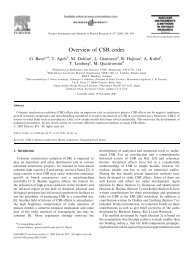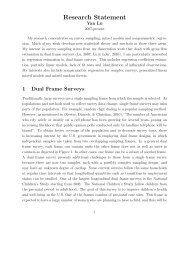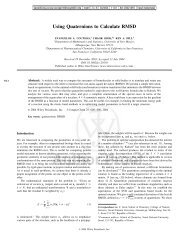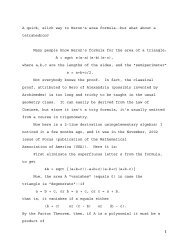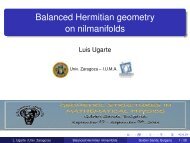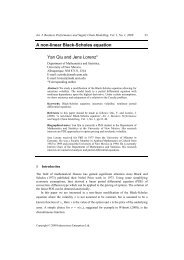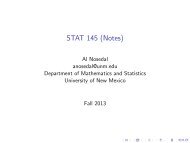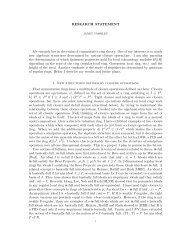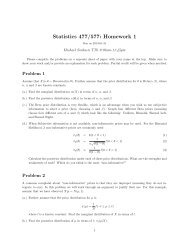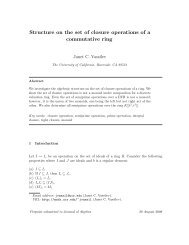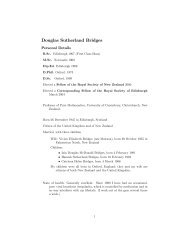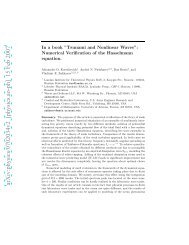Corollary 0.6 will follow readily from the general method used to tackle <strong>Theorem</strong> 0.4.Vojta’s result [V1] is better by a factor <strong>of</strong> two on the second term on the right; for an analysis<strong>of</strong> this situation, see [EV1] §10.The drawback with <strong>Theorem</strong> 0.4 is the dependence on the Q-divisor D. It is not clear,given an arbitrary line bundle L on X, how to compute the “best” or minimal D. In someinstances, however, such as the line bundles used by Faltings [F1] <strong>and</strong> Vojta [V4], one hascontrol over D <strong>and</strong> it would perhaps be interesting to carry out the pro<strong>of</strong> <strong>of</strong> the Mordellconjecture in [V4] using <strong>Theorem</strong> 0.4.Our pro<strong>of</strong> <strong>of</strong> <strong>Theorem</strong> 0.4 combines ideas <strong>of</strong> <strong>Esnault</strong> <strong>and</strong> <strong>Viehweg</strong> [EV1], Vojta [V1], <strong>and</strong>Faltings [F1]. In broad outline, the pro<strong>of</strong> follows [EV1] §1 – §5 very closely. In particular,we derive <strong>Theorem</strong> 0.4 from the positivity <strong>of</strong> a certain sheaf constructed from L <strong>and</strong> thepositivity statement is shown by induction on the dimension <strong>of</strong> product subvarieties. But ourconstruction is more direct in that instead <strong>of</strong> working with weak positivity <strong>of</strong> direct imagesheaves we take “derivatives” <strong>of</strong> the section s <strong>and</strong> use a result resembling Faltings’ Product<strong>Theorem</strong>. Most <strong>of</strong> the results <strong>of</strong> [EV1] §1 – §5 carry over to the more general setting withlittle or no modification. An exception, however, is [EV1] §2 where the pro<strong>of</strong>s, relying onexplicit constructions <strong>of</strong> multihomogeneous polynomials, need to be replaced with somewhatmore abstract methods. In particular, the Q–divisor D in the statement <strong>of</strong> <strong>Theorem</strong> 0.4 isnecessary in order to derive the analogue <strong>of</strong> [EV1] <strong>Lemma</strong> 2.9 (ii).In simplifying the logic <strong>of</strong> the pro<strong>of</strong>, we hope to make the more technical sections <strong>of</strong> [EV1]available to a wider audience. A fundamental insight <strong>of</strong> [EV1], exploited most fully by Vojta[V1, V2, V3], is that lower bounds on vanishing come from arithmetic conditions while theupper bounds are purely geometric. The full significance <strong>of</strong> the methods <strong>of</strong> weakly positivesheaves <strong>and</strong> their relation to diophantine problems have not been completely understood. Inparticular, one might hope to use weak positivity in order to give a more “geometric” pro<strong>of</strong><strong>of</strong> the results in [F2].The stucture <strong>of</strong> the paper is as follows. In order to prove <strong>Theorem</strong> 0.4 it suffices to showthat a certain sheaf is positive; in practice, this means producing more sections s ′ ∈ H 0 (X, L)with index at least t i at ζ i . If there were enough such sections to generate L <strong>of</strong>f <strong>of</strong> the pointsζ i , <strong>Theorem</strong> 0.4 would follow immediately. In full generality, however, s might be the onlyglobal section <strong>of</strong> L with index at least t i at ζ i . In order to produce more sections, we takederivatives <strong>of</strong> s. This is straightforward in the case when X is a product <strong>of</strong> projective linesbut in general more care is necessary <strong>and</strong> we introduce the necessary definitions in section 1.In section 2 we show, following [EV1] §5, how to deduce <strong>Theorem</strong> 0.4 from the positivity <strong>of</strong>an invertible sheaf. The positivity result is shown in two steps, occupying sections 3 <strong>and</strong> 4respectively. First one shows that after taking a “bounded” number <strong>of</strong> derivatives <strong>of</strong> s, theextra sections generate except on a finite union <strong>of</strong> proper product subvarieties. This allowsone to induct on the dimension <strong>of</strong> X <strong>and</strong> the inductive step is carried out in section 4. Atthe end <strong>of</strong> section 4 we show how to derive Vojta’s result [V1] with the techniques developedto prove <strong>Theorem</strong> 0.4.Acknowledgments.This paper forms part <strong>of</strong> my Ph.D. thesis <strong>and</strong> it is a pleasure to thank my advisor Serge4
Lang for his encouragement <strong>and</strong> guidance. I would also like to thank H. <strong>Esnault</strong>, E. <strong>Viehweg</strong>,P. Vojta, <strong>and</strong> especially R. Lazarsfeld for many stimulating conversations without which thiswork could not have been completed.Notation <strong>and</strong> Conventions• On a variety X, a Q-Cartier divisor is an element <strong>of</strong> Div(X) ⊗Q where Div(X) is thegroup <strong>of</strong> Cartier divisors on X.• A Q-Cartier divisor on X is said to be numerically effective or nef for short if D·C ≥ 0for all integral curves C ⊂ X (<strong>of</strong> course the product D·C is just the intersection producton Cartier divisors <strong>and</strong> is extended by linearity to Div(X) ⊗ Q).• If F is a coherent sheaf on X then h i (X, F) = dim H i (X, F).• When X is smooth K X denotes the canonical bundle on X.• If f : X → Y is a morphism <strong>of</strong> schemes <strong>and</strong> I is an ideal sheaf on Y , then we writef −1 I for the inverse image ideal sheaf on X (cf. [H] p. 163).1 PreliminariesAs in the introduction, fix once <strong>and</strong> for all a product <strong>of</strong> smooth projective curvesX = C 1 × . . . × C m .An important special case (the case h<strong>and</strong>led by [EV1]), which we will consider in some depthas it has the advantage <strong>of</strong> being very concrete, is that <strong>of</strong> a product <strong>of</strong> m projective lines:LetP = P 1 1 × . . . × P1 m .R = k[X 1 , Y 1 , . . .,X m , Y m ]denote the projective coordinate ring <strong>of</strong> P. If I ⊂ R is a homogeneous ideal, then denoteby V (I) ⊂ P the associated subscheme <strong>and</strong> by Z(I) = V (I) red the underlying point set. Wewill <strong>of</strong>ten work on a fixed product affine open subset A = ∏ mi=1 A 1 i ⊂ P where each A 1 i isgiven by, say, Y i ≠ 0. Let ξ i denote the affine coordinate on A 1 i . For an m–tuple <strong>of</strong> integersd = (d 1 , . . .,d m ) writem⊗O P (d) = πi ∗ O P 1(d i).ii=1In what follows we will not distinguish between a global section P ∈ H 0 [O P (d)] <strong>and</strong> theassociated polynomial in several variables P A .5



